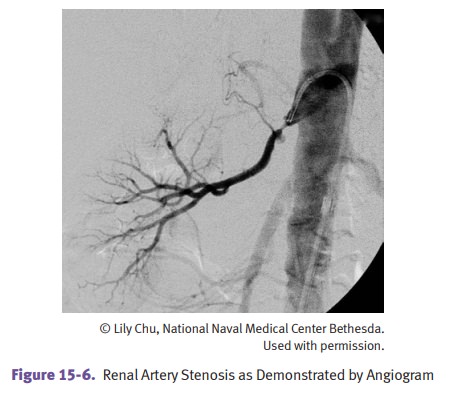Chapter: Pathology: Renal Pathology
Vascular Disorders of the Kidney
VASCULAR DISORDERS OF THE KIDNEY
Renal artery stenosis of any etiology causes
decreased blood flow to the involved kidney, with resulting secondary
hypertension that is often not responsive to anti-hypertensive medications.
Treatment is usually surgical.
•
Atheromatous plaque is the most common cause of renal artery
stenosis.
•
Dysplastic lesions (“fibromuscular dysplasia”) are an important
additional cause of renal artery stenosis.
•
All 3 lesion types occur in middle-aged adults.
o Medial fibroplasia with
aneurysms (most common) causes alternating stenosis and aneurysms in “string
of beads” pattern on arteriography
o Perimedial fibroplasia
involves the outer media
o Medial hyperplasia
•
Miscellaneous diseases that can affect the renal arteries (with or
without ste nosis) include congenital anomalies, Takayasu arteritis, and
radiation injuries.

Benign nephrosclerosis is caused by hypertension.
The kidneys have a finely gran-ular external surface and on microscopy show
hyaline arteriolosclerosis, tubular atrophy, interstitial fibrosis, and
glomerulosclerosis. Lab findings include mild pro-teinuria, hematuria, and
azotemia.
Malignant (accelerated) hypertension can damage the kidney,
causing fibrinoid necrosis of arterioles,
glomerulitis, and hyperplastic arteriolosclerosis. Clinically, it causes
cerebral edema, papilledema, retinal hemorrhage, intracerebral hemorrhage, and
oliguric acute renal failure. The cortical surface shows pinpoint petechial
hem-orrhages (“flea-bitten” look).
Renal infarction is due to thrombi from the
left side of the heart, atheroembolic disease, and vasculitis. It presents
with sudden onset of flank pain and hematuria. Small infarcts may be
asymptomatic.
Sickle cell anemia can cause medullary
infarctions due to blockage of blood flow in the medullary vessels,
which can result in asymptomatic hematuria, loss of urine concentrating
ability, renal papillary necrosis, and pyelonephritis.
Diffuse cortical necrosis can cause anuria; the
condition can occur with obstetric emergencies and disseminated
intravascular coagulation.
Related Topics